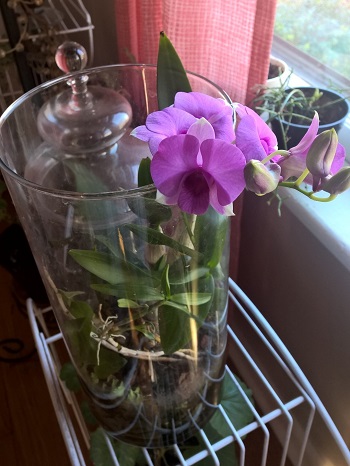
Like a lot of people I am an orchid lover who lacks a greenhouse. I have tried different ways to grow orchids inside the house. There was a time when I exclusively grew them in the bathroom for the humidity, but my window ledge is so small they were always falling. Heaven forbid if I wanted to open the window for a fresh breeze because the orchids always tumbled. My next thought was to grow them in the open and constantly mist them. Needless to say that got old fast, and my walls looked like they had polka dots from the water stains.
My last brainstorm has been the most successful: growing in terrariums. I searched online for terrariums and found pitiful options: terrariums that had no ventilation, terrariums that cost way too much and terrariums that came with the plants. I didn’t need any of these so I settled on apothecary jars from craft stores. They are very popular in home décor so it takes little effort to find them locally. And even better, they are a practical option that costs around $20 for each jar.
An apothecary jar is made of glass which allows light to reach the orchid. It holds water so I don’t have to worry about spills on my wood floors, and the jars hold humidity. Of course this is not a perfect method. Too much standing water will kill an orchid, so every few weeks I have to drain the excess water from the bottom of the jar. At times the jar will become saturated with humidity so I am constantly taking lids on and off.
Size is another issue to consider with apothecary jars as they can only handle small or miniature orchids. Due diligence is necessary in researching suitable orchid species. I tend to look for orchids that can handle cool temperatures (my house is cold over winter), low light (my orchids live in front of a North facing window) and a lot of water so I don’t have to empty the jar every day.
I maintain my terrarium orchids with loving distance. Too much pampering and they will die. All of the terrariums are in my dining room which faces north so I don’t have to worry about direct sunlight harming the leaves. I usually water once a week and each terrarium is given enough water to maybe fill a shot glass. They do not need to be watered with as much fervor as you would a geranium. It is more important to give orchids humidity, than water. While orchids should be fertilized frequently, my orchids are lucky to be given fertilizer 2-3 times during the winter.
During the summer the orchids are placed in apothecary jars on a screened in porch. I would be lying if I said they all survived and thrived. This past summer I had two orchids that could not handle the change in environments and died, but the other three orchids thrived. They loved the natural sunlight, temperatures, humidity in the air and wind. It was amazing to watch them produce new leaves and grow so fast compared to during winter.
After an orchid stops blooming it may be time to repot some of it. Let it rest for a bit and then separate the plant allowing the cycle to continue.
Lyndsey Roth is an experienced gardener and greenhouse grower.




Comment here